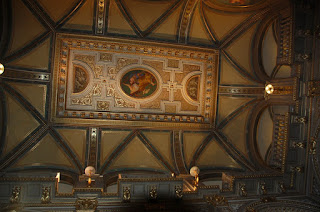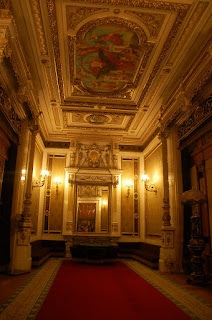Before WWII, Jews played an important part in Austrian economic and cultural life. In 1938, there were close to 200,000 Jews in Austria, about 4% of the Austrian population, the majority living in Vienna and very close to where we were staying. They were just under 10% of the city's population. Just one year later, their numbers had fallen to 57,000, primarily due to emigration.
The Germans entered on March 12, 1938 and were welcomed by the vast majority of Austrians, 99% of whom voted for the union with Germany, in a vote where Jews and Gypsies were not allowed to cast their ballot. Mauthausen became the main concentration camp in Austria, from where Jews were deported to the death camps in Germany. By the end of 1942, 7000 Jews remained in Austria, many married to non-Jews. The Austrians and Germans used their sense of organization and precision to systematically erase Jews from Austria, where they had once occupied positions of leadership in culture and the arts.
So as we were marvelling at the beauty of this beautiful city, we could not erase our thoughts for how amazing and alive it once was for the Jewish community and we somehow looked at elderly Viennese citizens that we passed in the street, elegantly and immaculately dressed, and made the subconscious calculation of just how old they might have been in the WWII years and whether they were involved.
It was here that the pogrom of Kristallnacht occurred on November 9-10, 1938, where all synagogues (over 90) and prayer houses (except for one, the Stadttempel - The City Temple) in Vienna were burned; Jewish shops plundered and 6000 Jews arrested and deported to their deaths in Dachau in the following days.
And while we loved the city and its beauty, our enjoyment was dampened by the knowledge of exactly what happened here just a short time ago.
Today, there are about 10000 Jews in Vienna and the 2nd district of Leopoldstadt continues to be the centre of Jewish life. There are functioning synagogues and educational institutions as well as kosher restaurants and shops.
As we were walking about in the centre of the city, within the Ringstrasse, we came upon memorials to the Jews and Jewish life that had almost been extinguished.
As we were walking past the State Opera House we saw the Monument against War and Fascism. This was erected in 1988 in the Albertinaplatz and is supposed to commemorate the Austrians who were murdered in Mauthausen.
However this monument came under great public criticism for a number of reasons. From the general Austrian population, they preferred not to be reminded of their complicity in the Nazi destruction of the Jewish community. Others felt that the location right beside the State Opera was not appropriate; after all, Austrians were models of culture, and their musical heritage might be insulted by such grim reminders.
But perhaps most important, the Jewish community was offended that there was no mention of Jews; merely "all victims of war". And so, Simon Wiesenthal who lived in Vienna, campaigned for a separate Holocaust memorial which was eventually erected in the Judenplatz in 2000.
We continued touring the centre of the city and came to the very famous Cafe Sacher, home of one of the most famous Viennese culinary desserts, Sachertorte, invented by Franz Sacher in 1832, whose recipe remains a closely guarded secret till today. Too bad it is not kosher, but it was still good to include the place in our itinerary.
We passed by an open air market as we made our way thru the city and marvelled at how neat and clean all the fruits were, perfectly organized on their stands. Great place for a healthy snack.
We now headed back thru the city in the northerly direction so that we could get lunch in one of the restaurants in the second district of Leopoldstadt and passed architecturally beautiful sites, including a statue of one of the most recognized names in Vienna, Mozart, born in Salzburg in 1756 and died in Vienna in 1791.
The area in Leopoldstadt where the kosher restaurants were located was easily recognizable as a Jewish area from the chassidic garb of the locals. Many of the younger members made their way around the area on bike or scooter.
After a light lunch, we made our way back to the area near the Opera House for our scheduled tour. The Opera House which seats 1700 people was completed in 1869 and was the first major building on the Ringstrasse. There are tours throughout the day and it is a very busy place indeed. All the while, workmen are setting the stage for that evening's performance. You literally have to look in all directions as you walk on the tour, as the ceilings, walls, stairways and floor are all ornately decorated. Really a work of art. Definitely worth the visit.
After a wonderful Opera House Tour, we made our way to the Stadttempel, the only shul to survive Kristallnacht. The only reason it survived, was that it was situated in the middle of an apartment block and destroying it would have likely caused the destruction of most of the city centre. The entire area is closed off to traffic with armed security at each end of the street, so as to guarantee quiet in the city. This is a city that is built for tourism, the last thing they need is an incident which would cause people to travel elsewhere. We joined a minyan for mincha and then ended our day with a wonderful meal at the restaurant next door Alef Alef.
The end of an amazing day. Next, our trip out to Schonbrunn Palace, our visit to the Jewish Museum and the area around Judenplatz.










































No comments:
Post a Comment